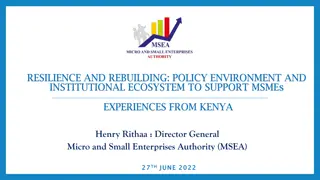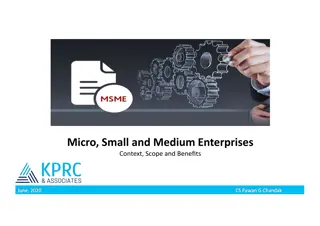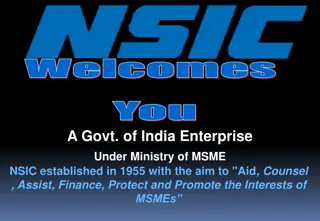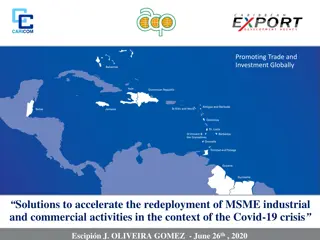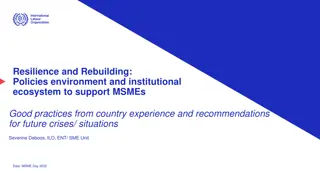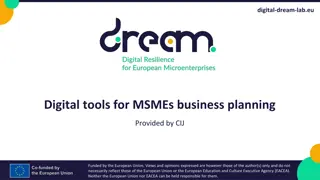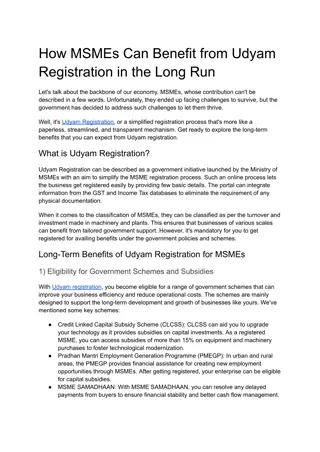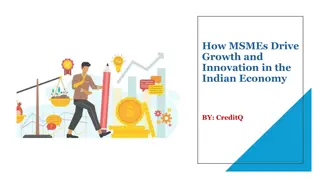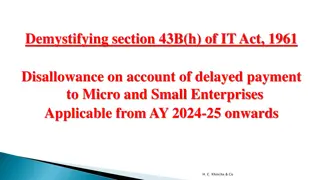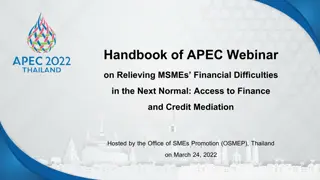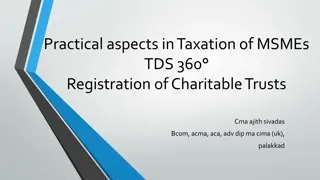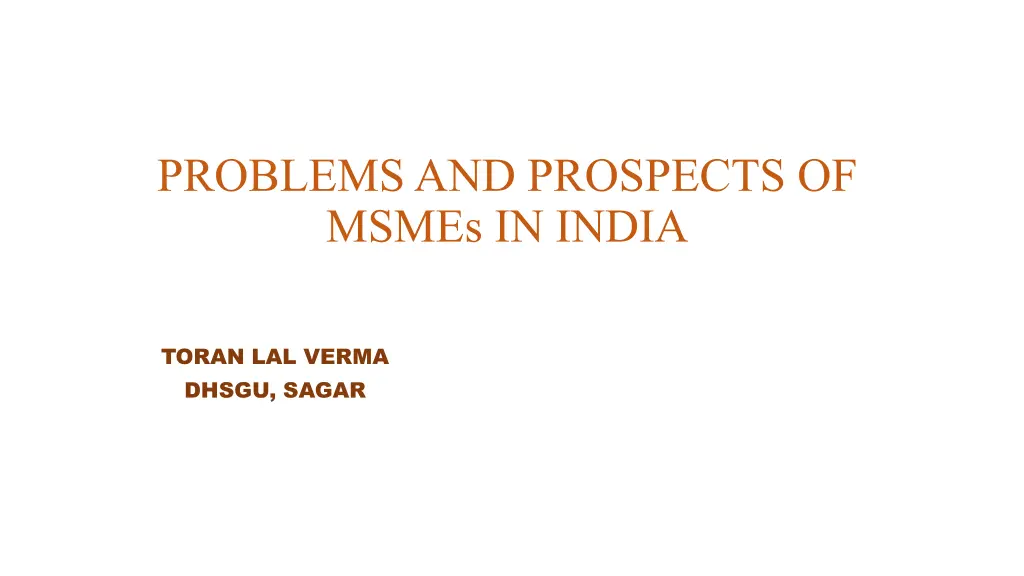
Challenges and Opportunities for MSMEs in India
The Micro, Small, and Medium Enterprises (MSME) sector in India plays a crucial role in economic development, contributing significantly to manufacturing output, exports, GDP, and employment. This article discusses the importance of MSMEs, major sectors, updates on the new definition, and their role in the Indian economy, emphasizing employment generation, GDP contribution, exports, and inclusive growth.
Download Presentation

Please find below an Image/Link to download the presentation.
The content on the website is provided AS IS for your information and personal use only. It may not be sold, licensed, or shared on other websites without obtaining consent from the author. If you encounter any issues during the download, it is possible that the publisher has removed the file from their server.
You are allowed to download the files provided on this website for personal or commercial use, subject to the condition that they are used lawfully. All files are the property of their respective owners.
The content on the website is provided AS IS for your information and personal use only. It may not be sold, licensed, or shared on other websites without obtaining consent from the author.
E N D
Presentation Transcript
PROBLEMS AND PROSPECTS OF MSMEs IN INDIA TORAN LAL VERMA DHSGU, SAGAR
MSMEs Micro, Small and Medium Enterprises (MSME) sector is the backbone of our economy and plays a significant role in economic development. It is acknowledged worldwide that MSMEs are important contributors to a nation's economic and social development. In India, The MSME sector contributes to 45% of the total manufacturing output, 40% of the total export, 6% of the manufacturing GDP and 24.63% of the GDP from service activities, employs over 8 crore people and produces over 8000 products. Not only it supports large industries with their inputs but also it Ensures inclusive growth of the nation by supporting the rural economy. Most of the MSMEs are situated in rural areas and employ rural manpower.
UPDATE ON NEW DEFINITION The government has removed the criteria of service and manufacturing enterprises in the newly formed definition in June 2020. The new definition will be helpful in easily identifying MSMEs and framing policies for them.
Role and Importance of MSMEs for Indian Economy 1. Employment: It is the second largest employment generating sector after agriculture. It provides employment to around 120 million persons in India. 2. Contribution to GDP: With around 42 million units throughout the geographical expanse of the country, MSMEs contribute around 6.11% of the manufacturing GDP and 24.63% of the GDP from service activities. MSME ministry has set a target to up its contribution to GDP to 50% by 2025 as India becomes a $5 trillion economy. 3. Exports: It contributes around 45% of the overall exports from India. 4. Inclusive growth: MSMEs promote inclusive growth by providing employment opportunities in rural areas especially to people belonging to weaker sections of the society. For example: Khadi and Village industries require low per capita investment and employs a large number of women in rural areas.
5. Promote innovation: It provides opportunity for budding entrepreneurs to build creative products boosting business competition and fuels growth. 6. Plays an important role in making Make in India possible: Since the MSME is the backbone in making this dream a possibility, the government has directed the financial institution to lend more credit to enterprises in MSME sector. 7. Poverty alleviation: by providing employment to a large number of people in india, MSMEs are helping people in earning money to survive and come out of poverty. 8. Rural Development: MSMEs are mostly situated in rural areas and are helping in rural development.
PROBLEMS OF MSMEs IN INDIA Internal Problems External Problems
Internal Problems 1. One Man Army: MSMEs are usually managed by a single person who is owner of the enterprise. 2. Problem of finance: MSMEs face problem of finance from starting the business to operating the business. 3. No long-term vision: MSMEs are generally started without proper planning and long-term vision. Because of this, they fail to cope with the shocks in economy like demonetisation, GST and COVID-19. 4. Labour Problems: MSMEs face labour problems as they cant hire professionally skilled employees. 5. Inadequate Management Systems: MSMEs do not have adequate management systems. 6. Lack of Strategic Ideas: MSMEs are not very rich in financial resources and they cant spend much in research and development. 7. Poor organizational Structure: MSMEs do not have clear cut organizational structure.
External Problems 1. Lack of capital and financing 2. Lack of basic infrastructure 3. Complicated labour laws 4. unavailability of skilled labour 5. Poor distribution network 6. Delay in payment of Recievables and payables 7. Use of Outdated Technology 8. Lack of knowledge about government schemes
Suggestions for Improvement of MSME 1. Availability and Cost of Credit: Credit availability must be ensured to MSMEs at low interest rates. MUDRA loan is one such example. 2. Assistance in Marketing: the government must assist MSMEs in marketing their products. Trade shows and exhibitions can be a good way to assist in marketing. 3. Increased Productivity: There should be an effective amendment of labour laws to enable more overtime hours for employees. It should also offer opportunities for more women employment and ensure safety for women to work in night shifts. 4. Technology Upgradation: Demands enhancement of technology upgradation schemes with capital subsidy and interest subsidies for fast technological adoption. 5. Skill Development: More funds research/resource/product development and incubation centers. There should be effective coordination with the technical institutions and CSIR laboratories. should be allotted to set up
6. Improve Infrastructure: 24x7 facilities for export consignments at major air cargo/sea port complexes, enhancement of ASIDE scheme and development of MSME clusters near highways/rail corridors. 7. Fix incentives/Tax related issues: There should be a new corporate/income tax regime for MSME exporters, incorporate a different ECGC policy for MSMEs to reduce costs. Bring in efforts to remove service tax on conversion of export proceeds remittances and other issues which will reduce transaction costs in exports. 8. Develop an Institutional Framework: Creation of a Standing Committee of Secretaries to resolve policy and implementation related issues will initiate greater changes in the sector. There should also be a greater coordination at the ground level between Customs and DGFT offices. 9. Resolve Sector Specific Issues: increase fund allocation to resolve issue relating to sectors such as handicrafts and leather industries. Immediate steps need to be taken to
Government schemes to promote MSMEs 1. Udyami Mitra Portal : launched by SIDBI to improve accessibility of credit and handholding services to MSMEs. 2. MSME Sambandh: To monitor the implementation of the public procurement from MSMEs by Central Public Sector Enterprises. 3. MSME Samadhaan: MSME Delayed Payment Portal will empower Micro and Small entrepreneurs across the country to directly register their cases relating to delayed Ministries/Departments/CPSEs/State Governments. 4. Digital MSME Scheme : It involves usage of Cloud Computing where MSMEs use the internet to access common as well as tailor-made IT infrastructure 5. Prime Minister Employment Generation Programme : It is a credit linked subsidy program under Ministry of MSME. payments by Central
6. Revamped Scheme of Fund for Regeneration Of Traditional Industries (SFURTI) : organizes traditional industries and artisans into clusters and make them competitive by enhancing their marketability & equipping them with improved skills. 7. A Scheme for Promoting Entrepreneurship (ASPIRE): creates new jobs & reduce unemployment, promotes entrepreneurship culture, facilitates innovative business solution etc. 8. National Manufacturing Competitiveness Programme (NMCP): to develop global competitiveness among Indian MSMEs by improving their processes, designs, technology and market access. 9. Micro & Small Enterprises Cluster Development Programme (MSE- CDP) - adopts cluster development approach for enhancing the productivity and competitiveness as well as capacity building of MSEs. 10.Credit Linked Capital Subsidy Scheme (CLCSS) is operational for upgradation of technology for MSMEs. Innovation, Rural Industry &
References: http://www.supportbiz.com/articles/managing-growth/top-10-ways-improve- indian-sme-sector.html https://www.drishtiias.com/to-the-points/paper3/micro-small-and-medium- enterprises-msme Ministry of MSME, Governement of India






